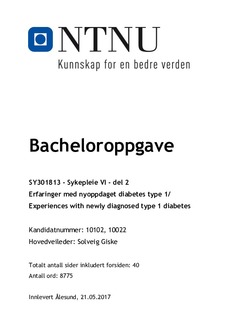| dc.contributor.advisor | Giske, Solveig | |
| dc.contributor.author | Hollevik, Ida | |
| dc.contributor.author | Adolfsen, Maiken Svanem | |
| dc.date.accessioned | 2017-10-25T13:01:30Z | |
| dc.date.available | 2017-10-25T13:01:30Z | |
| dc.date.issued | 2017 | |
| dc.identifier.uri | http://hdl.handle.net/11250/2462140 | |
| dc.description.abstract | Bakgrunn: Norge ligger på topp med svært høy forekomst av diabetes type 1. Hvert år får
over 300 barn under 15 år diagnosen.
Hensikt: Å undersøke barn med nyoppdaget diabetes type 1 og deres foreldres erfaringer
når barnet er innlagt på en barneavdeling.
Metode: Oppgaven bygger på en systematisk litteraturstudie, hvor det er inkludert åtte
kvalitative forskningsartikler.
Resultat: Når et barn blir nydiagnostisert med diabetes type 1, involveres også foreldrene.
Det oppstår fysiologiske og psykologiske reaksjoner, da sykdommen ofte oppstår uventet.
Barn og foreldre har behov for tilrettelagt kommunikasjon, samt god relasjon med
sykepleier. Foreldrene oppfattet informasjonen og undervisningen som intens, og de
mottok ofte informasjon på barnas vegne. Barna ble engasjert når visuelle hjelpemidler ble
tatt i bruk i undervisningen.
Konklusjon: Under sykehusinnleggelsen forsto ikke barna hva som foregikk rundt de. De
opplevde kroppslige endringer i forkant, og det var skremmende å få en kronisk diagnose.
Foreldrenes tilstedeværelse var svært viktig. På diagnosetidspunktet opplevde foreldre å
være i sjokk, og hadde behov for emosjonell støtte. I en slik situasjon er det sentralt at
sykepleier har kunnskap om krise, for å kunne tilrettelegge informasjon og undervisning,
slik at informasjonen blir forstått og de husker det de blir lært. | nb_NO |
| dc.description.abstract | Background: Norway is at the top with very high prevalence of type 1 diabetes. More
than 300 children under the age of 15 are diagnosed each year.
Objective: To investigate children with newly diagnosed type 1 diabetes and their parents’
experiences when the child is admitted to the pediatric ward.
Method: This assignment is based on a systematic literature study, which includes eight
qualitative research articles.
Results: When a child is diagnosed with type 1 diabetes, their parents are very involved.
There are physiological and psychological reactions, because diabetes in many cases
occurs unexpectedly. Children and parents need appropriate communication, and the
relationship with the nurses was proved to be important. Parents perceived the information
and teaching as intense, and they often received information on behalf of their children.
The children became engaged when visual tools were used in the teaching.
Conclusion: During the hospitalization the children did not understand what was
happening around them. They experienced bodily changes at the forefront, and it was scary
to be diagnosed with a chronic diagnosis. The parents’ presence was very important. At the
time of diagnosis, parents felt being in shock and needed emotional support. In such
situations, it’s important that nurses have knowledge of crisis in order to facilitate
information and education so that the information is understood and the remember what
they are being taught. | nb_NO |
| dc.language.iso | nob | nb_NO |
| dc.rights | Attribution-NonCommercial-NoDerivatives 4.0 Internasjonal | * |
| dc.rights.uri | http://creativecommons.org/licenses/by-nc-nd/4.0/deed.no | * |
| dc.subject | Diabetes type 1 | nb_NO |
| dc.subject | Barn | nb_NO |
| dc.subject | Foreldrenes opplevelser | nb_NO |
| dc.title | Erfaringer med nyoppdaget diabetes type 1 | nb_NO |
| dc.title.alternative | Experiences with newly diagnosed type 1 diabetes | nb_NO |
| dc.type | Bachelor thesis | nb_NO |
| dc.subject.nsi | VDP::Medical disciplines: 700::Health sciences: 800::Nursing science: 808 | nb_NO |
| dc.source.pagenumber | 40 | nb_NO |

